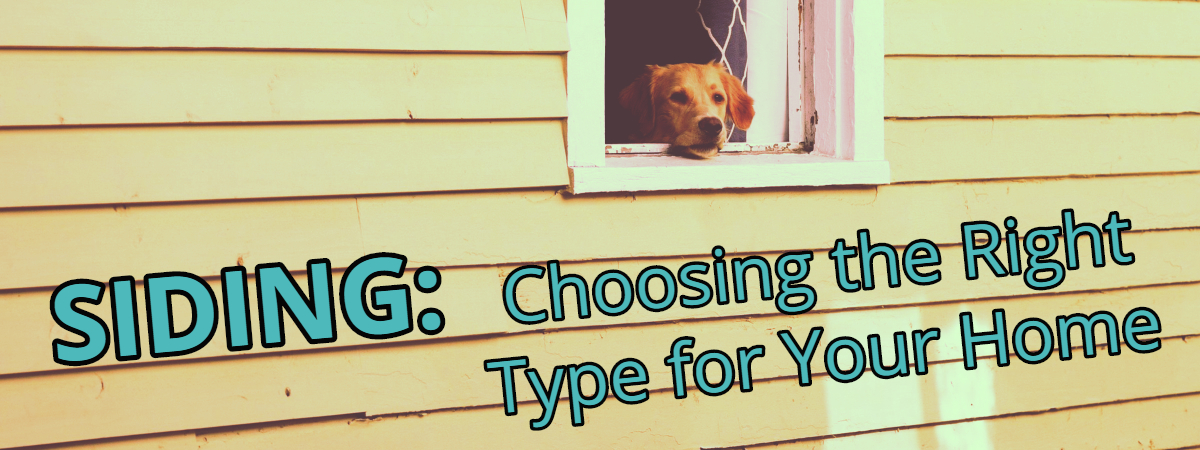Siding: Choosing the Right Type for Your Home

When it comes time to replace the siding of your home, it’s important to consider a multitude of factors. Budget, installation time, durability, aesthetic, energy efficiency, life expectancy, water resistance, color and texture options, and maintenance are a few of the most common points you will want to keep in mind. With all of that to sort through, let’s take a look at some of the siding options available to you.
Vinyl Siding
One of the most economical options on our list, vinyl siding currently dominates much of the market. Vinyl provides good durability, but can be scratched or dented – unlike the harder materials on this list – and can warp over time in harsh weather conditions. Vinyl siding is not waterproof, but it is water resistant, and proper installation is the key to keeping water from getting behind it and creating water damage and mold issues. Insulated vinyl siding. which is more expensive, can help cut energy costs. Color options in vinyl are vast, and chances are you can find the hue you’re looking for with a little shopping around. New vinyl is typically under warranty from the manufacturer for a few decades and is incredibly easy to clean with a power washer.
Metal Siding
One of the less conventional choices, metal siding comes in a variety of material options, but the most common are steel and aluminum. Metal comes with a few advantages, including that it cannot harbor mold, won’t rot, and resists insects. On the other hand, metal siding is heavy and more expensive to install, does have the possibility of rusting over time, and requires sealing in order to keep the rust away.
Wood Siding
The old standby, wood siding comes with quite a few advantages. It is energy-efficient right out of the box and provides a near limitless amount of color options because it is either stained or painted. However, the stain and paint is where the high amount of maintenance comes into play, as staining is recommended every 2 to 3 years, and painting every 4 to 5 years. If damaged, single tiles of wood siding can be replaced individually rather than whole sections. When choosing wood siding, you do run the risk of rot and insect infestations, so careful routine inspections for problems is necessary.
Fiber Cement Siding
A lesser-known but often-seen alternative to vinyl siding, fiber cement is a composite of sand, cement, and cellulose fibers. This combination of materials allows the final product to be resistant to fire, weather changes, salt air in coastal regions, and insects. Although rather heavy and costly to install, fiber cement offers a good life expectancy and only needs to be repainted when chipped or scratched, or about every 12 years or so.
Brick
The classic-turned-contemporary darling, brick has made a big comeback recently, and with good reason. Brick siding can easily last over 100 years if washed occasionally, and is highly fire resistant. You don’t need to worry about termites or other insects and it never needs to be repainted or sealed. Another point to consider is that because of these positive attributes, insurance companies sometimes factor the brick siding into lowering a home insurance premium. However, brick siding is expensive, sometimes around $10-$15 per square foot and your color options are limited to reds and browns. Finally, repairs to mortar joints can be a little more than the average homeowner wants to deal with, and repair bills can quickly add up.
Stucco
Made from a mixture of lime, sand, and cement, stucco is installed by putting a wire mesh over wood lath and then saturating the wood lath and wire mesh with the stucco material. Stucco is fairly durable and can last 50 to 100 years with a bit of upkeep. Damage can be repaired easily without having to remove entire parts of the siding, but damage will be one of the your biggest concerns over time. Stucco is susceptible to cracking as the contraction and expansion of the siding takes place through the seasons.
Stone
Finally, stone is the very expensive and long-lasting king of siding. There are two options available: real stone and faux stone. Installation of either type is time-consuming and costly, and faux stone encounters the same weather-related issues as stucco. As far as positives go, stone requires no maintenance and can be cleaned easily with a power washer. Stone siding is resistant to moisture, insects, fire, and even extreme temperatures. Ultimately, stone is the most expensive option, but you get what you pay for back in durability and ease of upkeep.
As you can see, there are quite a few ways of looking at solving your siding issue. Maybe you’re looking to spend a little more to lower your future maintenance costs or want to go with a more budget-friendly option that can be adapted or replaced at a later point in time. Whatever your needs, there is a siding option out there that will meet them.
At Select Home Exteriors, our trained professionals can help guide you through the siding selection process. Contact us today for a no-pressure visit from one of our experienced consultants!
